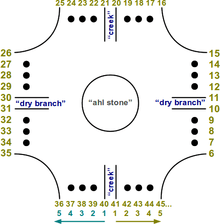Zohn Ahl

Zohn Ahl ("creek" "wood") is a roll-and-move board game played by the Kiowa Indians of North America. It is often[1] cited as a typical representative of many similar Native American games. It is often equated (or possibly confounded) with Tsoñä ("awl game"), also played by the Kiowa.[2]
Terminology
Note that the two names create an interesting but coincidental sonic overlap: Zohn = "creek," a feature of the board; and Ahl = "wood," the term for the dice. Whereas Tsoñä means the "awl game," referring to the 2 awls used as playing pieces. But "ahl" and "awl" have no relation to each other, one being a Kiowa word, the other English, and signifying different objects. So while the game may be referred to as "Zohn Ahl" or "the Awl Game" or even "the Ahl Game" (meaning "the stick dice game"), "Zohn Awl" would be incorrect.
Equipment
- Board: the distinctive 40-space board (see illustration) was marked on a cotton cloth or a blanket.
- Lots: four stick dice (ahl). These are split sticks, flat on one side and round on the other (thus semicircular in section), ranging anywhere from about 4 to 10 inches long, and around 3/8 to 1/2 inch in diameter. Three of these stick dice are marked on their flat sides with grooves painted red; the fourth is marked with a groove painted blue, black, or green. In the Tsoñä account, this specially marked fourth stick die is called sahe ("green"). The round sides of the two types are usually also distinguished, though this is not necessary for gameplay. Willow and elm are mentioned as materials.
- Flat stone: the "ahl stone," is placed in the center of the board, and the stick dice are vigorously bounced against it for each throw.
- Pieces: two awls, one for each player or team, mark progress around the circuit.
- Counters: eight sticks (or any even number) used to keep score.
Gameplay
The game is played between either two players or two equal teams. Each side begins with half the counters and its awl at its own space 1, the awls moving in opposite directions, one side clockwise, the other counterclockwise (see illustration). A player throws the four stick dice and moves her awl the indicated number of spaces, and if appropriate, throws again (see table). The fact that "throwing" is said to go around the circle counterclockwise (which would be meaningless in alternate turns) may indicate that, when playing in teams, all players on one side throw and move, followed by all players on the other side in their turn.
The four 2-sided stick dice, one with a specially marked flat side (sahe, "green"), can fall in eight possible configurations, yielding the indicated values:
| Flat sides up | Value | Value with sahe |
|---|---|---|
| 0 | 10+ | NA |
| 1 | 1 | 1+ |
| 2 | 2 | 2 |
| 3 | 3 | 3+ |
| 4 | NA | 6+ |
("+" means "and throw again". "NA" mean "not applicable"; the throw is not possible.)
When a player lands on her space 20, the near bank of the "creek," she "falls in": her side loses one counter and the awl is returned to the beginning space 1. (Note that an opponent's space 20 is the far side of the creek, and safe.) Likewise when a player lands on her opponent's awl, the opponent is "whipped" back to her space 1, and loses one counter. The "dry branch" spaces have no special effect, and function just as any other space.
When a player completes a full circuit with her awl, she wins one counter, and continues around in the same direction, moving the full value of her throw. If, however, her throw causes her to land on her space 40, she falls into the creek and is returned to space 1, losing one counter.
The game is won when one side wins all the counters.
References
- ↑ Culin 1898, pp 685–88. Bell 1960, pp 4–5. Parlett 1999, pp 38–40.
- ↑ Bell 1960, pp 4–5. Parlett 1999, pp 38–40. Stewart Culin (1898, pp 687–88 and 731–33) (1907, pp 124–27) presents the 2 accounts of Zohn Ahl and Tsoñä together. The description of Zohn Ahl fails to distinguish the throws of the special 4th stick die; and the description of Tsoñä fails to mention how counters are won or lost; but both descriptions include both the special stick die and counters. Therefore, very possibly these texts refer to the same game, which can be reconstructed only by consulting both to fill in their respective holes. This is the perspective taken here. Note, however, that Murray (1951, pp 154–55) considers them distinct variants. Except where otherwise noted, this article summarizes Culin's full composite treatment (Culin 1907, pp 124–130).
Bibliography
- Bell, R. C. (1960), Board and Table Games [1] (rev. 1969 and rpt. with vol 2 as Board and Table Games from Many Civilizations Mineola, NY: Dover, 1979 ed.), London: Oxford University Press, ISBN 0-486-23855-5
- Bell, R. C. (1983). "Zohn Ahl". The Boardgame Book. Exeter Books. pp. 36–7. ISBN 0-671-06030-9.
- Culin, Stewart (1898), Chess and Playing-Cards (rpt. New York: Arno Press, 1976 ed.), Washington DC: US National Museum, ISBN 0-405-07916-8
- Culin, Stewart (1907), Games of the North American Indians (rpt. Mineola, NY: Dover, 1975 ed.), Washington DC: Government Printing Office, ISBN 0-486-23125-9
- Murray, H. J. R. (1951), A History of Board-Games Other Than Chess (rpt. Oxford: Oxbow Books, 2002 ed.), Oxford: Oxford University Press, ISBN 0-19-827401-7
- Parlett, David (1999), The Oxford History of Board Games, Oxford: Oxford University Press, ISBN 0-19-212998-8